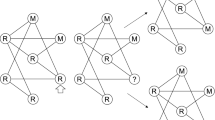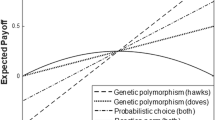Abstract
Building on previous work, we derive an optimization model for a two-state stochastic environment and evaluate the fitnesses of five reproductive strategies across generations. To do this, we characterize spatiotemporal variation and define grain (=patch) size as the scale of fitness autocorrelation. Fitness functions of environmental condition are Gaussian. The strategies include two specialists on each of the environmental conditions; two generalists that each fare equally well under both conditions, but one (a conservative bet hedger) optimizes the shape of the fitness function; and a diversified bet hedger producing an optimal mix of the two specialists within individual broods. When the environment is primarily in one of the two states, the specialist on that state achieves the highest fitness. In the more interesting situation where the two environments are equally prevalent in the long term, with low-moderate environmental variation, a generalist strategy (that copes with both states well) does best. Higher variation favors diversified bet hedgers, or surprisingly, specialists, depending mainly on whether spatial or temporal variation predominates. These strategies reduce variance in fitness and optimize the distribution of offspring among patches differently: specialists by spreading offspring among many independently varying patches, while diversified bet hedgers put all offspring into a few patches or a single patch. We distinguish features consistent with strategies like diversified bet hedgers that spread risk in time from features linked to strategies like specialists that spread risk in space. Finally, we present testable hypotheses arising from this study and suggest directions for future work.





Similar content being viewed by others
References
Bulmer M (1994) Theoretical evolutionary ecology. Sinauer Associates, Inc., Sunderland MA
Childs DZ, Metcalf CJE, Rees M (2010) Evolutionary bet-hedging in the real world: empirical evidence and challenges revealed by plants. Proc R Soc B 277:3055–3064
Cohen D (1966) Optimizing reproduction in a randomly varying environment. J Theor Biol 12:119–129
Crowley PH and Hopper KR (2015) Mechanisms for adaptive cohort splitting. Ecol Model 308:1–13
Crowley PH, Saeki Y (2009) Balancing the size-number tradeoff in clonal broods. Open Ecol J 2:100–111
Dall SRX (2010) Managing risk: the perils of uncertainty. In: Westneat DF, Fox CW (eds) Evolutionary behavioral ecology. Oxford University Press, Oxford, pp 194–206
Dall SRX, Cuthill IC (1997) The information costs of generalism. Oikos 80:197–202
Davies NB, Krebs JR, West SA (2012) An introduction to behavioural ecology, 4th edn. Wiley-Blackwell, Oxford
Dempster ER (1955) Maintenance of genetic heterogeneity. Cold Spring Harb Symp Quant Biol 20:25–32
Forsman A, Ahnesjö J, Caesar S (2007) Fitness benefits of diverse offspring in pygmy grasshoppers. Evol Ecol Res 9:1305–1318
Fox CW, Rauter CM (2003) Bet-hedging and the evolution of multiple mating. Evol Ecol Res 5:273–286
Frank SA (2011) Natural selection. 1. Variable environments and uncertain returns on investment. J Evol Biol 24:2299–2309
Frank SA, Slatkin M (1990) Evolution in a variable environment. Am Nat 136:244–260
Futuyma DJ, Moreno G (1988) The evolution of ecological specialization. Annu Rev Ecol Syst 19:207–233
Gabriel W, Luttbeg B, Sih A, Tollrian R (2005) Environmental tolerance, heterogeneity and the evolution of reversible plastic responses. Am Nat 166:339–353
García-Roger EM, Serra M, Carmona MJ (2014) Bet-hedging in diapausing egg hatching of temporary rotifer populations—a review of models and new insights. Int Rev Hydrobiol 99:96–106
Gillespie JH (1974) Natural-selection for within-generation variance in offspring number. Genetics 76:601–606
Gillespie JH (1975) Natural-selection for within-generation variance in offspring number. 2. Discrete haploid models. Genetics 81:403–413
Hakalahti T, Häkkinen H, Valtonen ET (2004) Ectoparasite argulis coregoni (crustacea: Branchiura) hedge their bets—studies on egg hatching dynamics. Oikos 107:295–302
Hopper KR (1999) Risk-spreading and bet-hedging in insect population biology. Annu Rev Entomol 44:535–560
Hopper KR, Rosenheim JA, Prout T, Oppenheim SJ (2003) Within-generation bet hedging: a seductive explanation? Oikos 101:219–222
Levins R (1962) Theory of fitness in a heterogeneous environment. I. The fitness set and adaptive function. Am Nat 96:361–373
Levins R (1968) Evolution in changing environments: some theoretical explorations. Princeton University Press, Princeton NJ
Lewontin RC, Cohen D (1969) On population growth in a randomly varying environment. Proc Natl Acad Sci U S A 62:1056–1060
Lu JJ, Tan DY, Baskin JM, Baskin CC (2012) Phenotypic plasticity and bet-hedging in a heterocarpic winter annual/spring ephemeral cold desert species of Brassicaceae. Oikos 121:357–366
Moran N (1992) The evolutionary maintenance of alternative phenotypes. Am Nat 139:971–989
Needham T (1993) A visual explanation of Jensen’s inequality. Am Math Mon 100:768–771
Philippi T, Seger J (1989) Hedging one’s evolutionary bets, revisited. Trends Ecol Evol 4:41–44
Pigliucci M (2001) Phenotypic plasticity: beyond nature and nurture. The Johns Hopkins University Press, Baltimore, MD USA
Polačik M, Blažek R, Režucha R, Vrtílek M, Terzibasi Tozzini E, Reichard M (2014) Alternative intrapopulation life-history strategies and their trade-offs in an African annual fish. J Evol Biol 27:854–865
Seger J, Brockmann HJ (1987) What is bet-hedging? Oxf Surv Evol Biol 4:182–211
Simons AM (2011) Modes of response to environmental change and the elusive empirical evidence for bet hedging. Proc R Soc Lond B 278:1601–1609
Starrfelt J, Kokko H (2012) Bet-hedging—a triple trade-off between means, variances and correlations. Biol Rev 87:742–755
The MathWorks, Inc (2012) MATLAB 7 software. MathWorks, Inc, Natick MA
Wright J, Ratikainen II (2012) Adaptive responses to environmental stochasticity. In: Ratikainen II (ed) Foraging in a variable world: adaptations to stochasticity. PhD dissertation. Norwegian University of Science & Technology (NTNU), Trondheim, Norway
Acknowledgments
We thank Aviv Brokman, Vincent Calgagno, Éric Wajnberg, Jon Wright, and the Crowley and Sih lab groups for comments on the project and manuscript. PHC thanks EK and AS, and EK thanks AS, for hospitality during sabbatical visits when many of these ideas were developed. SME acknowledges support from a National Science Foundation Graduate Research Fellowship; no other extramural funding supported this work. Contributions by author are as follows: PHC developed the models and wrote the draft manuscript; SME wrote most of the computer code in MATLAB and conducted the runs that generated the figures and Appendix C (supplementary materials); EK checked all of the mathematics; all four authors helped develop the ideas and approach and edited the manuscript.
Author information
Authors and Affiliations
Corresponding authors
Electronic supplementary material
Below is the link to the electronic supplementary material.
ESM 1
(DOCX 148 kb)
Rights and permissions
About this article
Cite this article
Crowley, P.H., Ehlman, S.M., Korn, E. et al. Dealing with stochastic environmental variation in space and time: bet hedging by generalist, specialist, and diversified strategies. Theor Ecol 9, 149–161 (2016). https://doi.org/10.1007/s12080-015-0272-x
Received:
Accepted:
Published:
Issue Date:
DOI: https://doi.org/10.1007/s12080-015-0272-x




